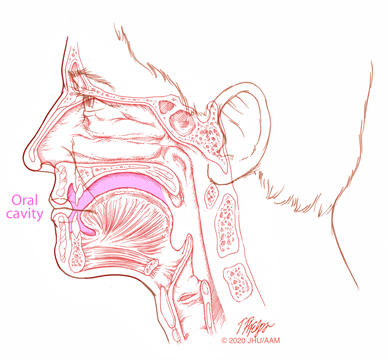Oral Cavity Cancer
What is the oral cavity?
Oral cancer is cancer found in the oral cavity (the mouth area). The oral cavity includes:
- The lips, teeth and gums
- The front two-thirds of the tongue
- The inner lining of the lips and cheeks (buccal mucosa)
- The area underneath the tongue (floor of the mouth)
- The roof of the mouth (hard palate)
- The small area behind the wisdom teeth (retromolar trigone)

What are the symptoms of oral cavity cancer?
Common symptoms of oral cancer include the following:
- A lip or mouth sore that does not heal
- A white or red patch on the gums, tongue or lining of the mouth
- A lump on the lip or in the mouth
- Unusual bleeding, pain or numbness in the mouth area
- Swelling of the jaw or neck
- Pain in the ear
- Pain or difficulty swallowing or chewing
Each person with oral cancer may experience different symptoms, and some symptoms of oral cancer may resemble those of other disorders or medical problems. Always consult your health care provider for a diagnosis.
Johns Hopkins Head and Neck Cancer Specialists

Our head and neck surgeons and speech-language pathologists take a proactive approach to cancer treatment. Meet the Johns Hopkins specialists who will work closely with you during your journey.
What are the causes of oral cavity cancer?
The main causes of oral cancer are:
- Tobacco use (including cigarettes, cigars, pipes and smokeless forms)
- Alcohol use
- Other causes include:
- Human papillomavirus (HPV) infection
- Excessive sun exposure to the lips
The frequency of oral cancers in people without recognized risk factors is growing.
How is oral cavity cancer evaluated and diagnosed?
In addition to a complete medical history and physical examination, diagnostic procedures for oral cancer may include one or more of the following:
- Biopsy. A procedure in which tissue samples are removed from the body. A pathologist examines the sample under a microscope to determine if cancer or other abnormal cells are present. For oral cancers, biopsies are often collected from the mouth area under local anesthesia in the doctor’s office. Samples are sometimes collected from the lymph nodes in the neck using a needle.
- Endoscopy. A small fiber-optic scope can be used to examine the throat for signs of cancer beyond the mouth area.
- Computerized tomography (CT) scan or magnetic resonance imaging (MRI). These are noninvasive procedures that take images of your body to detect abnormalities that may not show up on an ordinary X-ray.
- Ultrasonography. A noninvasive procedure that uses high-frequency sound waves to create an image of the internal organs. For oral cancer, ultrasonography may be used to examine or collect biopsies from the lymph nodes in the neck.
- Positron emission tomography (PET)/CT scan. A noninvasive procedure that uses special radioactive dyes that may help detect cancer in the body.
Once a diagnosis is made, the cancer is staged (to determine the extent of the cancer) before a treatment plan is established. Your health care provider determines which tests are needed for your specific situation.
What is the treatment for oral cavity cancer?
Treatment options for oral cancer include surgery, radiation therapy and chemotherapy. You may need only one type of treatment, or you may need a combination of treatments. Recommendations are usually made after consultation among the multidisciplinary team of oncologists (head and neck surgeons, radiation oncologists and medical oncologists) and a speech-language pathologist.
- Surgery. Surgery for oral cancer includes different surgical techniques that depend on the location, size and extent of the cancer. You may need surgery to remove the cancer from your mouth as well as to repair (reconstruct) your mouth after the cancer is removed. You may also need surgery to remove the lymph nodes from your neck if there is concern that the cancer may have spread there.
- Radiation therapy. Radiation therapy uses high-energy rays that damage cancer cells and halt the spread of the disease. Radiation therapy is very localized and is aimed at only the area where the cancer is present. This therapy is usually given externally with a machine, but it can be delivered internally with radioactive materials.
- Chemotherapy. Chemotherapy uses medications that go throughout the entire body to kill cancer cells. Chemotherapy may be given alone, or it can be used in combination with surgery or radiation therapy.
- Immunotherapy. Immunotherapy uses medications that help your body’s immune system fight the cancer. It may be given to people with advanced oral cancers that are not responding to standard therapies.
- Targeted therapies. For some patients, drugs that target specific cancer cells are an option. An example is cetuximab (Erbitux), which targets epidermal growth factor receptors.
Your health care provider will determine your treatment based on:
- Your age, overall health and medical history
- Location, size and extent of the cancer
- Your tolerance for specific medications and procedures
- Expectations for the course of the disease
- Your preference
Johns Hopkins Head and Neck Cancer Surgery

Our team offers comprehensive treatments for cancers affecting the nasal passages, sinuses, the throat and nearby areas. Our head and neck surgeons work closely with medical and radiation oncologists, endocrinologists and other specialists to provide well-rounded care.






